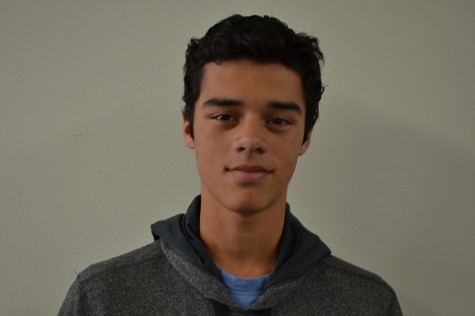Batman can scale walls, jump across buildings and quickly hurdle over obstacles. In parkour, people practice stunts and maneuvers similar to those in the movies.
“Parkour is split into two categories: There’s free running, which is getting from point A to point B in the fastest way possible. And there’s the tumbling and tricks par,” sophomore Austin Valenti said. “Some standard moves are kongs and reversals off benches and sometimes people go on to benches and jump from rooftop to rooftop.”
Valenti became involved in parkour after joining a class at Olympiad Gymnastics.
“I asked if they had a parkour class, and they said they had just started one a year ago, so I signed up for 10 bucks,” Valenti said. “I just ended the class because I couldn’t pay for it anymore.”
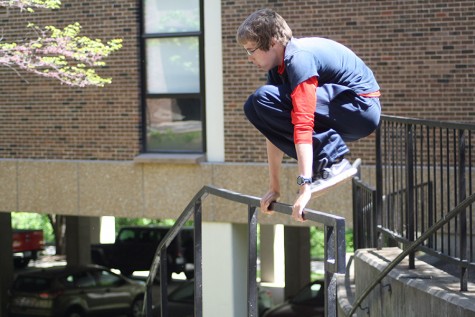
Freshman Joe Butler hurdles over a rail while practicing his parkour stunts.
While Valenti no longer attends the class, he continues to practice parkour.
“In the class, I had a couple friends, and we still get together sometimes and go to the park or school to practice,” Valenti said.
Freshman Joe Roseman, who has been practicing parkour for three years, recently started coaching the class at Olympiad Gymnastics.
“I started three years ago after seeing some interesting videos about it on YouTube. Now I’ve started coaching parkour at the gym where I was taking the classes,” Roseman said. “At first I was afraid, but I was surprised at how fast I got used to what I can actually do.”
As a coach, Roseman has learned that the style of parkour varies from person to person.
“Not everybody does the same thing – each person has their own style. So faster people normally do efficiency, point A to point B type stuff, but if you were a gymnast or martial artist before hand, then tumbling and flips would be more your area,” Roseman said.
For freshman Simon Everts, parkour started out a little differently.

Sophomore Austin Valenti climbs a wall in the peace garden.
“My friends are the ones that brought me into parkour last year. I was kind of overweight then, so things didn’t come to me as quickly as they did for others, but eventually I learned a few things,” Everts said.
Freshman Joe Butler has been practicing parkour on his own since second grade. He believes parkour is about personal improvement.
“There’s too many legal issues to starting a school club. It would be cool but it will never happen at our school. Parkour is about progressing in your own abilities, and gradually finding ways to get better, because after a while you need to get creative and find new moves,” Butler said.
Activities Director Brian Kessler agrees with Butler on the legality of a parkour club at school.
“Parkour is probably not something we’d do here at school, it’s not the right place for it. There’s too much liability, too much risk. But if it’s something that some kids like to do, then it’s great that they have a passion for it,” Kessler said.
Roseman has different plans for his future regarding parkour.
“I definitely want to expand. It’s not a very big thing right now and not many people know about it,” Roseman said. “But there are a few huge gyms around the country and that’s what I want to do in the future: open up a gym and become a trainer and coach at the gym.”
Despite the legality issues of becoming a school club, Valenti believes parkour is still a fulfilling and legitimate hobby.
“I would encourage people to go out and try parkour, because you can do it anywhere, it doesn’t cost money, its fun and you can get your friends to practice with you,” Valenti said. “But practice is the most important part. I mean, you’re not just going to go out your first day and walk up a wall.”


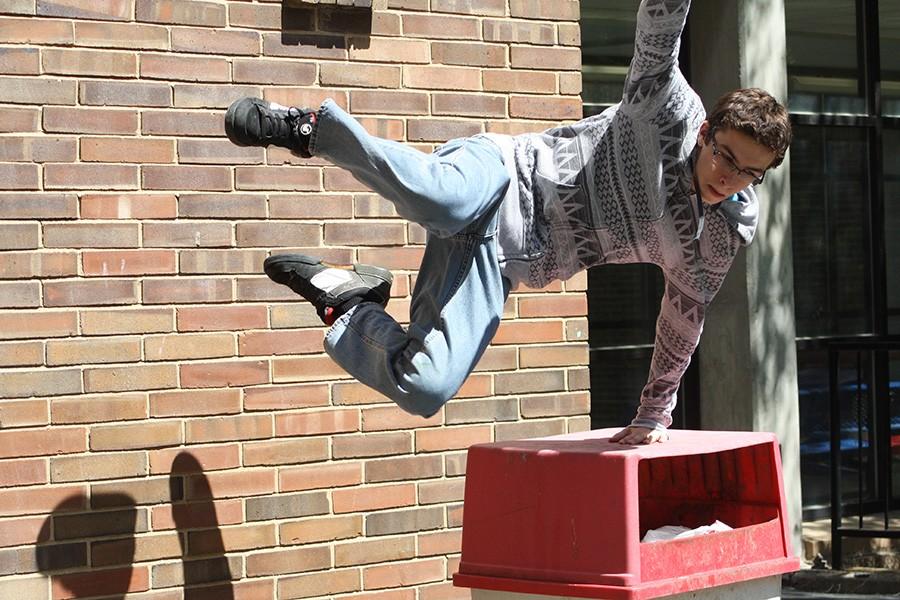
![Focused on providing exceptional service, sophomore Darsh Mahapatra carefully cleans the door of a customer’s car. Mahapatra has always believed his customers deserve nothing less than the best. “[If] they’re trusting us with their car and our service, then I am convinced that they deserve our 100 percent effort and beyond,” Mahapatra said.](https://pwestpathfinder.com/wp-content/uploads/2025/10/DSC_0018-1200x800.jpg)
![Sophomore Aleix Pi de Cabanyes Navarro (left) finishes up a soccer game while junior Ava Muench (right) warms up for cross country practice. The two came to Parkway West High School as exchange students for the 2025-2026 school year. “The goal for the [exchange] program is to provide opportunities for both Parkway students and our international exchange students to learn about other cultures, build connections and become confident, capable, curious and caring — Parkway’s Four C’s — in the process,” Exchange Program Lead Lauren Farrelly said.](https://pwestpathfinder.com/wp-content/uploads/2025/10/Feature-Photo-1200x800.png)
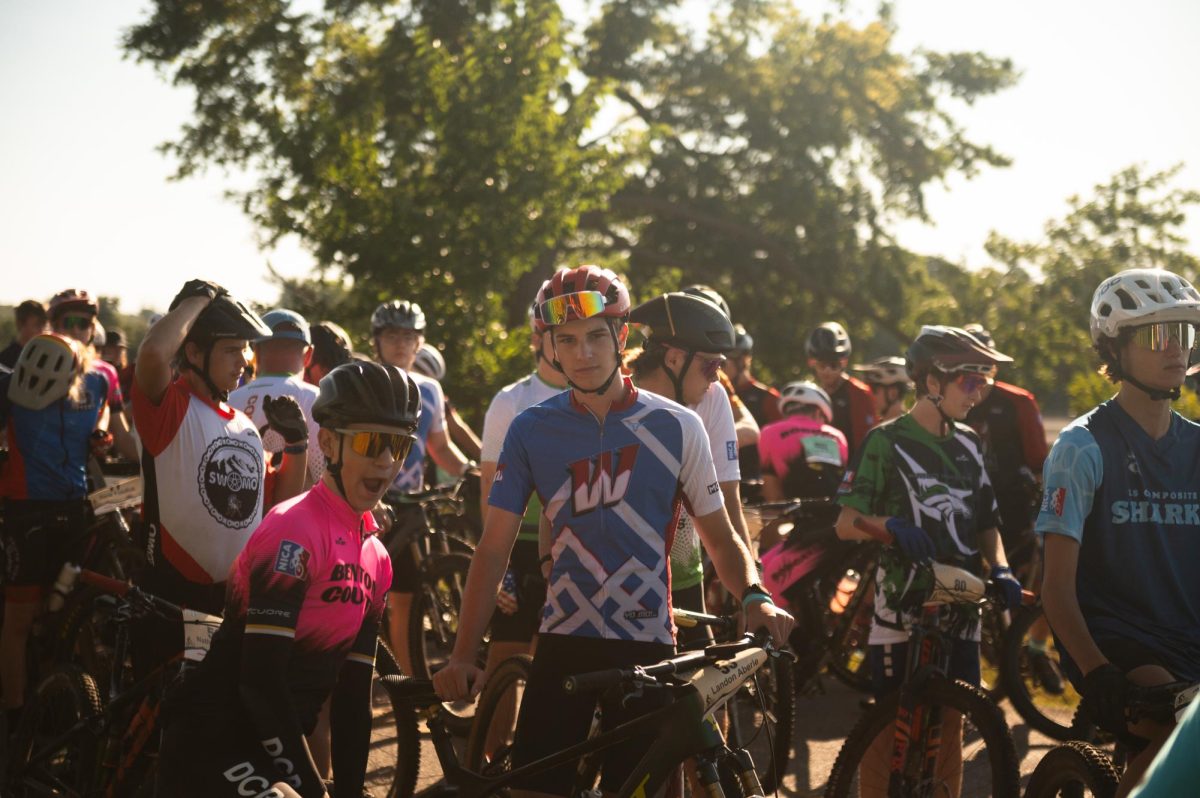
![Gazing across the stage, sophomore Alexis Monteleone performs in the school theater. The Monteleone family’s band “Monte and the Machine” has been releasing music since 2012, but Alexis started her own solo career in 2024 with the release of her first single, Crying Skies. “My whole family is very musical, [and I especially] love writing [songs with them],” Monteleone said.](https://pwestpathfinder.com/wp-content/uploads/2025/09/DSC7463-1200x798.jpg)
![Amid teaching a lesson to her AP Calculus BC class, Kristin Judd jokes alongside her students in their funny remarks. Judd has always enjoyed keeping the mood light in her classroom, along with on the volleyball court. “[I enjoy] that side talk where you see [or] overhear a conversation and chime in, or somebody says something funny,” Judd said.](https://pwestpathfinder.com/wp-content/uploads/2025/09/image-1200x730.jpg)
![Eyeing the ball, junior Ella McNeal poses for her commitment pictures at Clemson University. McNeal’s commitment comes after months of contact with top Division 1 soccer programs. “ It has taken a lot to get to where I am, but I know that [what] I've already been through is just the beginning, and I can't wait for what is to come,” McNeal said.](https://pwestpathfinder.com/wp-content/uploads/2025/09/IMG_4926-1200x900.jpeg)

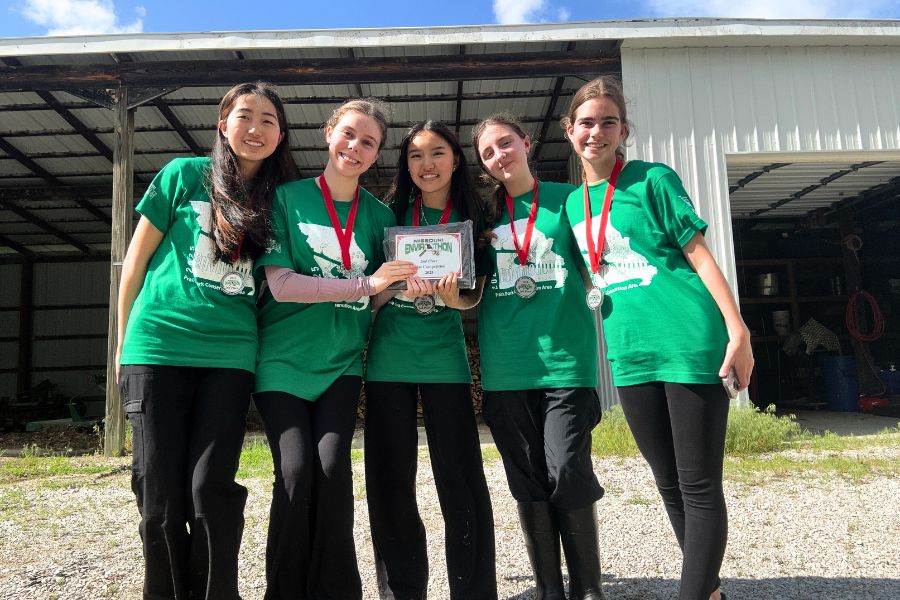
![Senior Adam Zerega stands with senior Dexter Brooks by farm equipment. Zerega often worked with friends and family on his farm. “I've been able to go to my family's farm since I was born. I [spend] at least three weekends a month [on the farm], so I'm there all the time,” Zerega said.](https://pwestpathfinder.com/wp-content/uploads/2025/04/IMG_4872-1200x900.jpg)
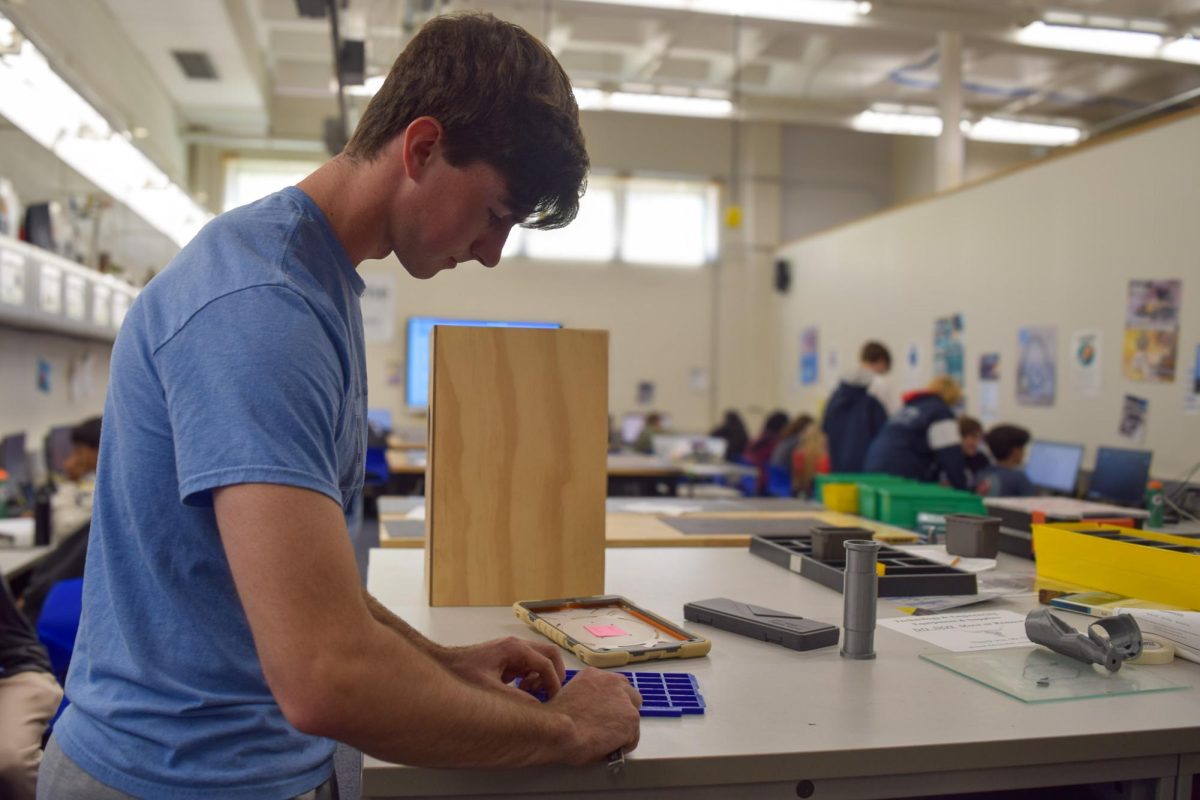
![Leaning on the podium, superintendent Melissa Schneider speaks to Parkway journalism students during a press conference. Schneider joined Parkway in July after working in the Thompson School District in Colorado. “My plan [to bond with students] is to get things on my calendar as much as possible. For example, being in [classes] is very special to me. I am trying to be opportunistic [meeting] kids [and] being in [the school] buildings. I have all the sports schedules and the fine arts schedules on my calendar, so that when I'm available, I can get to them,” Schneider said.](https://pwestpathfinder.com/wp-content/uploads/2025/09/IMG_5425-1200x943.jpeg)

![Leaping through the air, senior Tyler Watts celebrates his first goal of the season, which put the Longhorns up 1-0 against the Lafayette Lancers. Watts decided to play soccer for West for his last year of high school and secured a spot on the varsity roster. “[Playing soccer for West] is something I had always dreamed of, but hadn’t really had a good opportunity to do until now. It’s [really] fun being out [on the field], and I’m glad I decided to join the team. It’s just all about having fun with the boys and enjoying what time we have left together,” Watts said.](https://pwestpathfinder.com/wp-content/uploads/2025/09/DSC_1951-1200x855.jpg)

![Junior Fiona Dye lifts weights in Strength and Conditioning. Now that the Trump administration has instituted policies such as AI deregulation, tariffs and university funding freezes, women may have to work twice as hard to get half as far. "[Trump] wants America to be more divided; he wants to inspire hatred in people,” feminist club member and junior Clara Lazarini said.](https://pwestpathfinder.com/wp-content/uploads/2025/05/Flag.png)
![As the Trump administration cracks down on immigration, it scapegoats many immigrants for the United States’ plights, precipitating a possible genocide. Sophomore Annabella Whiteley moved from the United Kingdom when she was eight. “It’s pretty scary because I’m on a visa. When my visa expires next year, I’m not sure what’s going to happen, especially with [immigration] policies up in the air, so it is a concern for my family,” Whiteley said.](https://pwestpathfinder.com/wp-content/uploads/2025/05/DSC_0077-7copy.jpg)
![Shifting global trade, President Donald Trump’s tariffs are raising concerns about economic stability for the U.S. and other countries alike. “[The tariffs are] going to pose a distinct challenge to the U.S. economy and a challenge to the global economy on the whole because it's going to greatly upset who trades with who and where resources and products are going to come from,” social studies teacher Melvin Trotier said.](https://pwestpathfinder.com/wp-content/uploads/2025/05/MDB_3456-1200x800.jpg)

![Pitching the ball on Apr. 14, senior Henry Wild and his team play against Belleville East. Wild was named scholar athlete of the year by St. Louis Post-Dispatch after maintaining a high cumulative GPA and staying involved with athletics for all of high school. “It’s an amazing honor. I feel very blessed to have the opportunity to represent my school [and] what [it] stands for,” Wild said.](https://pwestpathfinder.com/wp-content/uploads/2025/05/unnamed-6-1200x714.jpg)
![Red, white and blue, the American flag holds the values of our democracy. The fight that we once endured has returned, as student journalists and senior correspondents across the country are losing their voices due to government control. “[Are] the White House and [the] government limiting free speech [and] freedom of the press? Yes [they are],” chief communications officer of the Parkway School District and former journalist Elisa Tomich said.](https://pwestpathfinder.com/wp-content/uploads/2025/03/Untitled-design-14.jpg)
